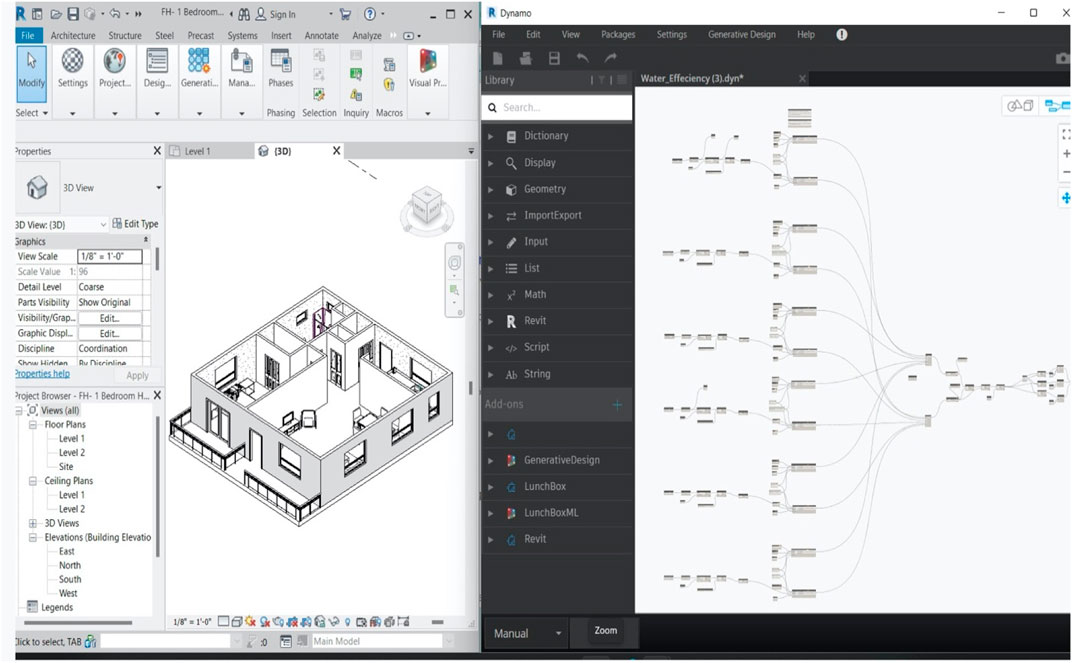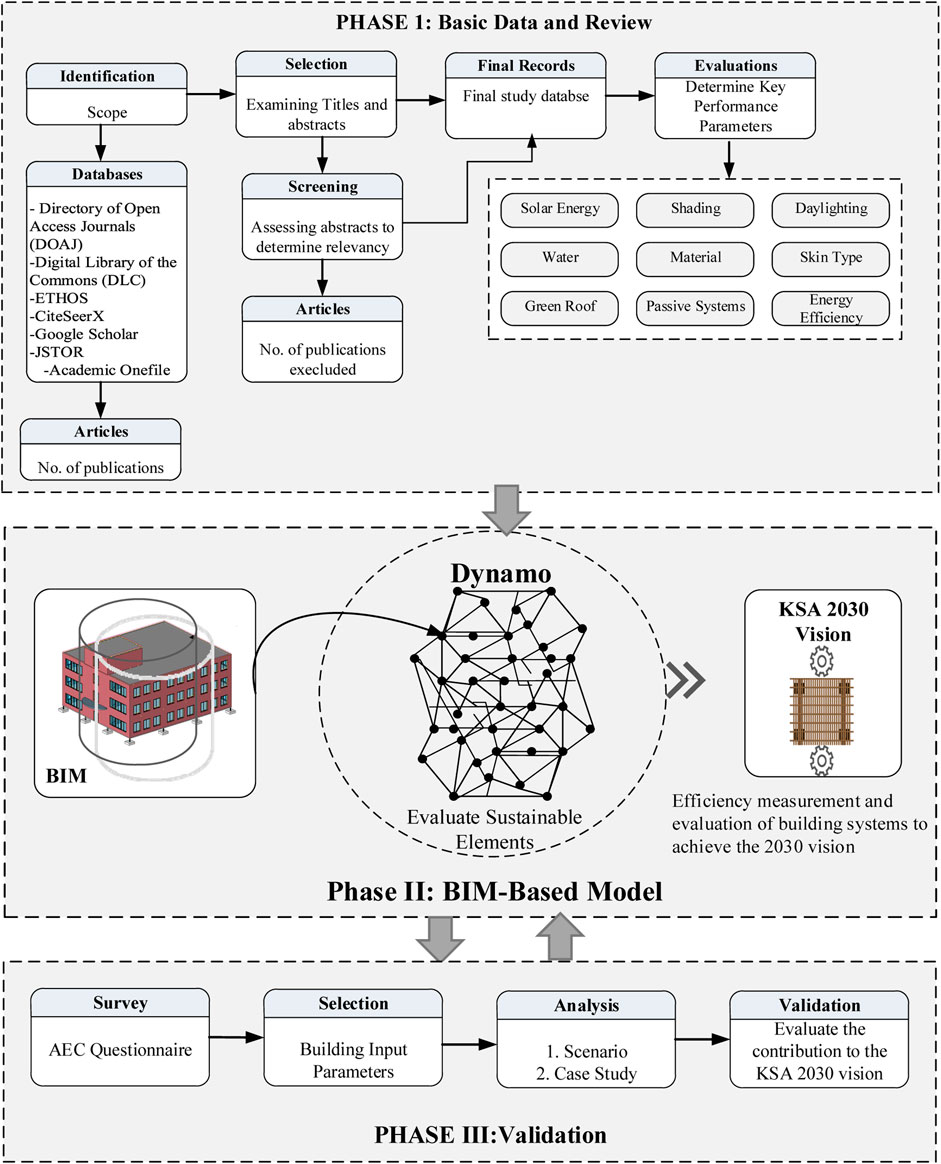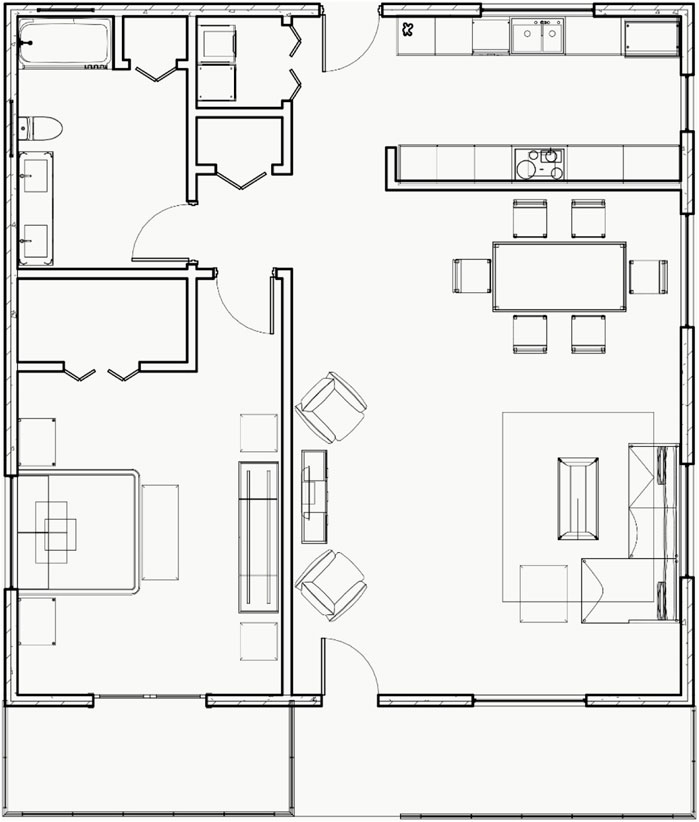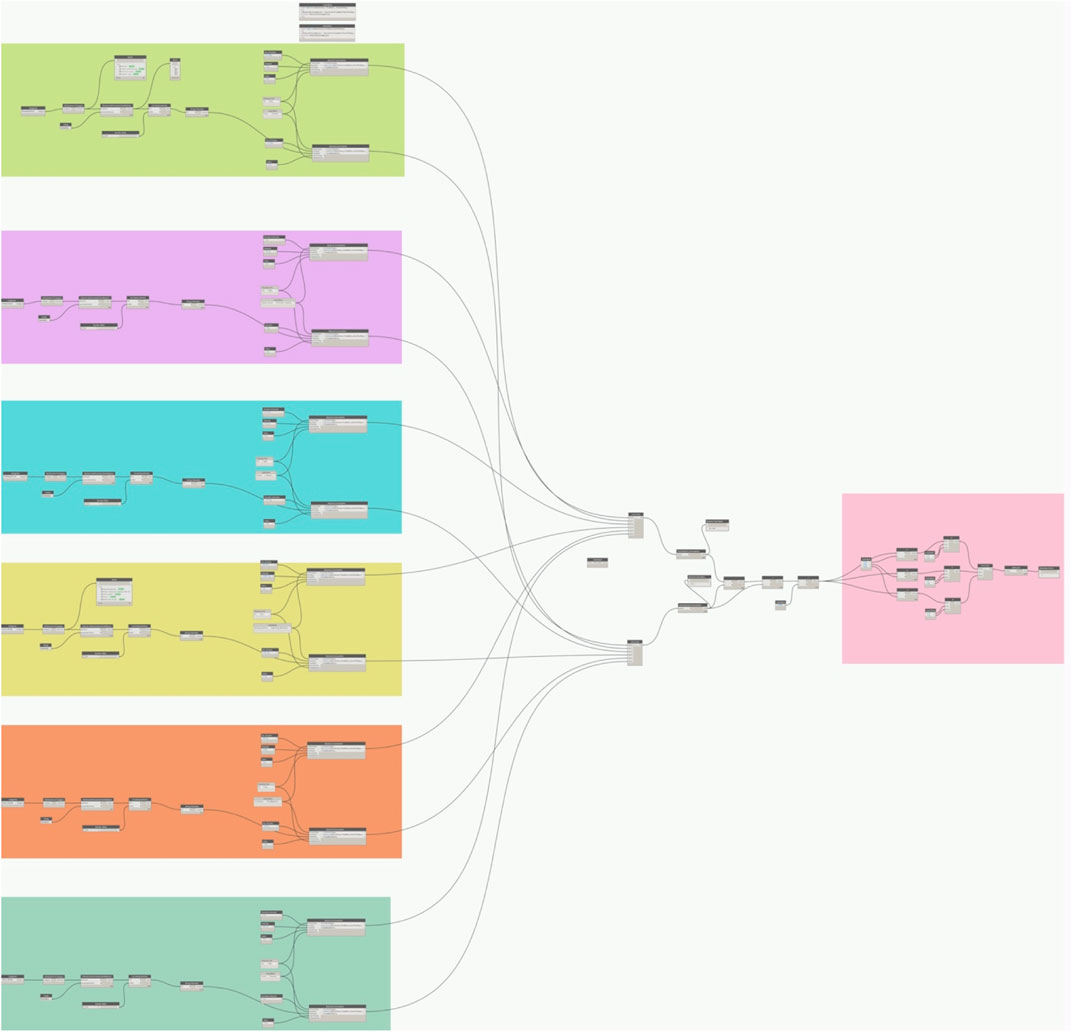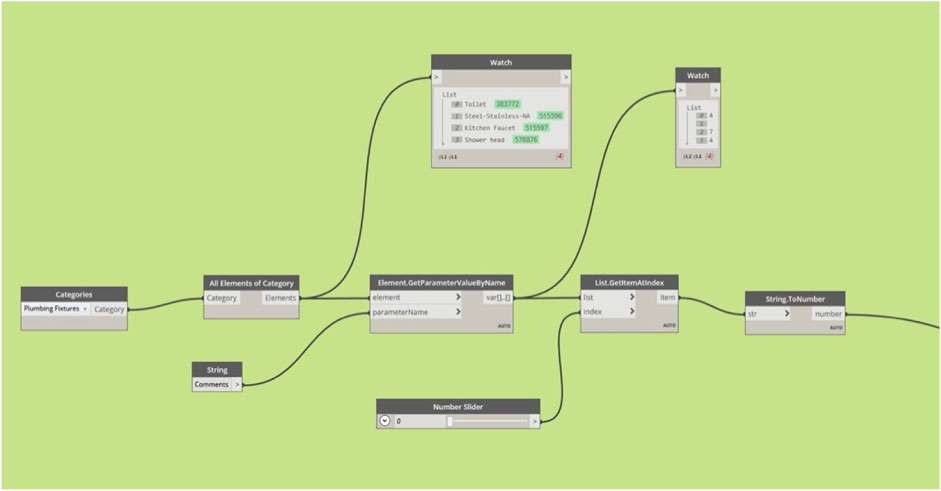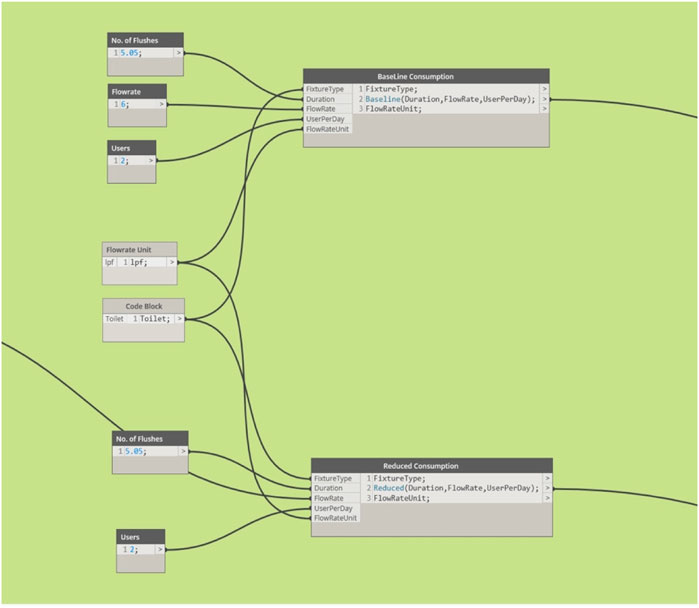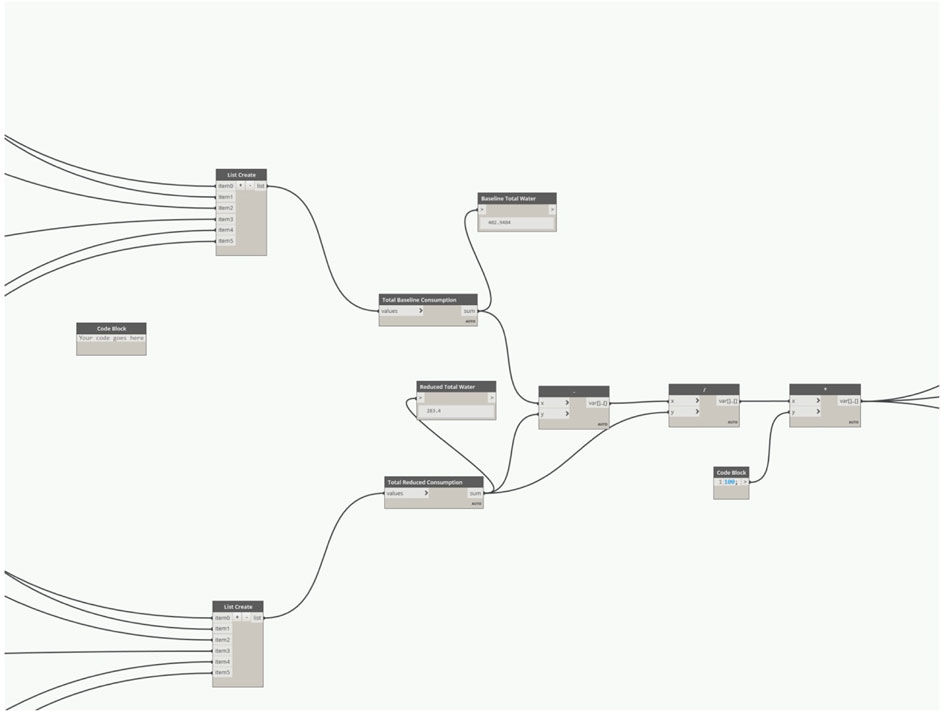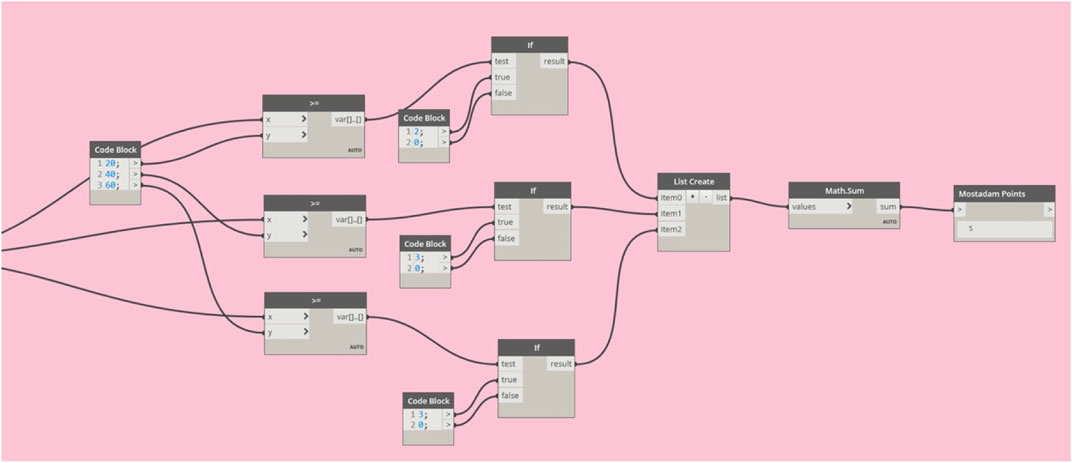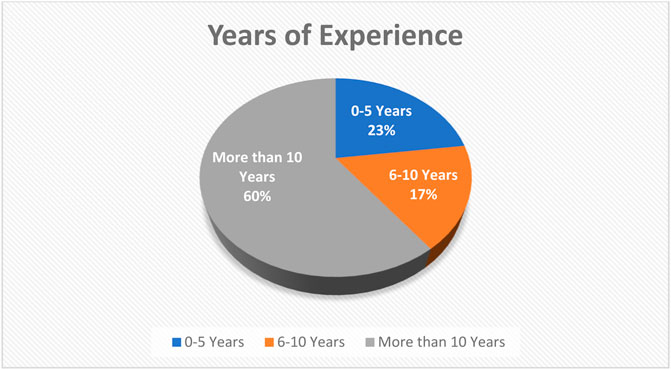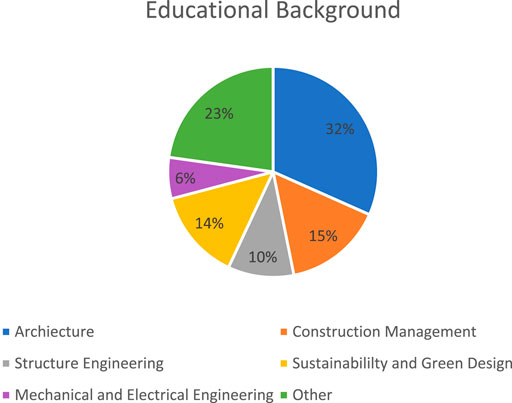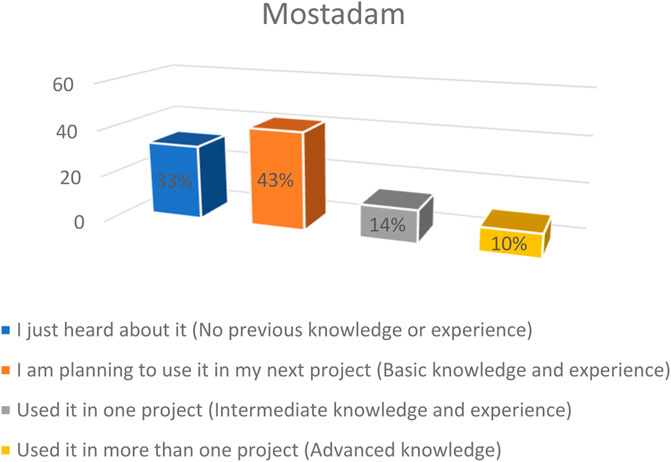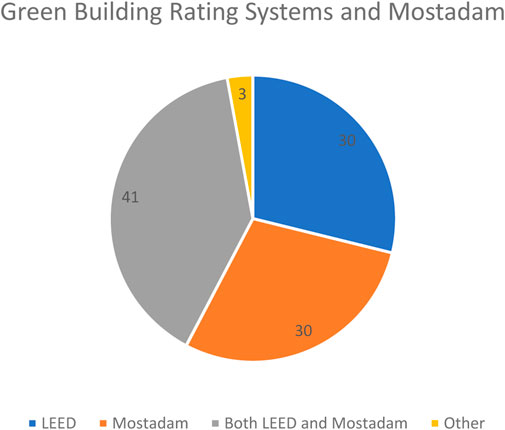- School of Architecture, College of Design, Construction, and Planning, University of Florida, Gainesville, FL, United States
BIM has had a significant influence on the building and construction industry, contributing to efficiency, productivity, and cost-effectiveness improvements. BIM technology’s integrative nature makes it a perfect platform for adopting sustainable techniques in new construction, renovation, and retrofitting of existing structures. Saudi Arabia’s market gasoline prices fell drastically between 2018 and 2020, forcing the Kingdom to create its 2030 vision. The 2030 vision seeks to transform the Kingdom of Saudi Arabia (KSA) into an ideal sustainable society by lowering its dependency on oil and constructing more sustainable buildings and infrastructures. The number of green buildings and high-performance buildings in the KSA is inadequate, and the rate of change is too slow. Due to KSA’s need to enhance its built environment, it established a new green building rating named “Mostadam.” Currently, there is no metric to measure the roadmap to achieve the aspects of the KSA’s 2030 vision, and the number of green buildings in the KSA is very low compared to other countries. Therefore, there is an urgent need to translate the KSA’s green objectives into effective regulations. To attain this goal, there must be uniformity across jurisdictions in order to make sound and well-informed decisions about adopting and enforcing sustainability. This research intends to focus on the advanced capability of using BIM and creating a BIM-Based model to help facilitate the green building certification in Saudi Arabia that supports its vision of 2030. The research proposes a new strategy based on the integration of BIM and Mostadam green building rating systems where a BIM plug-in can aid in achieving the 2030 envisioned water sustainability goal and implement sustainable design principles in Saudi Arabia. Autodesk Revit and Dynamo were used for programming and visualizing the model. The model focused on one main category of Mostadam’s Green Building Rating System: water conservation. This study used a mixed methodology that combines qualitative and quantitative approaches. Phase I of this study focuses on the literature review and collection of available data about BIM, Green Building Rating Systems, and the KSA 2030 vision. Phase II aims at collecting data from an online survey sent to AEC professionals. Moreover, phase II of this study includes developing a BIM-Based model using Autodesk Revit and Dynamo. Phase III embraces the validation of the model using a prototype and a case study. Driven from the data collected, the new BIM-Based model assisted in achieving the KSA 2030 vision by reducing the water consumption when compared to the baseline water consumption. The model’s constraints are presented along with future phases of the study.
1 Introduction
Following the discovery of oil in Saudi Arabia, petroleum became a primary industry. Saudi Arabia’s economy has grown and has been developing at a rapid pace since the 1980s, fueled by massive earnings from oil exports. Despite its past underdevelopment, Saudi Arabia’s wealth of resources has resulted in a number of development initiatives that have modernized the country and contributed to a low unemployment rate (Mahmood, Alkhateeb, & Furqan, 2020). Saudi Arabia’s market gasoline prices fell drastically between 2018 and 2020, forcing the Kingdom of Saudi Arabia (KSA) to establish its 2030 strategy. The 2030 vision aspires to transform Saudi Arabia into an ideal sustainable society by lowering its dependency on petroleum, building more sustainable structures, and utilizing renewable energy resources. When designing a perfect sustainable community, equal access to nourishment, healthcare, clean water, shelter, education, energy, economic opportunities, and jobs must be provided (Mostadam Green Building Rating System, 2020).
The KSA is the world’s leading producer and exporter of petroleum liquids and is also considered the Middle East’s leading consumer of petroleum liquids (EIA, 2020). The country’s economy is based on oil, and the energy sector is fully dependent on fossil fuels. In the KSA, investing in renewable energy and taking public transportation is discouraged; therefore, the Kingdom faces a severe problem with green gas emissions (Rahman & Khondaker, 2012). KSA is ranked 61st in the 2014 Climate Change Performance Ranking, the final position on the index (Burck, et al., 2013). As a result, it is critical for the KSA to reduce its environmental footprint and improve building sustainability (Taleb & Pitts, 2009).
Building Information Modeling (BIM) has been booming in the architectural, engineering, and construction (AEC) industry as it is being used in parallel with the continued momentum of the green building initiative during the past decade. Although entirely unrelated concepts at first glance, BIM and green building collectively are able to best address the unprecedented challenges in productivity and sustainability encountered by the AEC industry. Building Information Modeling has a tremendous effect on the building industry by increasing performance, cost-effectiveness, and productivity. Current building practices need more efficient tools to design high-performance, safe, and sustainable buildings that can achieve low carbon footprints (Everett et al., 2017). To do so, professionals in the building sector are increasingly expected to use environmental assessment systems to evaluate building efficiency in the design, construction, and operational phases (Singh et al., 2019).
Although various frameworks are such as BREEAM, LEED, CASBEE, and Mostadam now available to provide environmental assessments (Trusty, 2000), there is still a lack of convenient, reliable, and highly efficient tools that can be utilized to manage the overall assessment process using these schemes (Thérivel and Paridario, 2016; Kibert, 1994; Kibert, 2007; Kibert et al., 2002). This lack of tools has raised several critical issues that need to be considered while assessing the sustainability performance of buildings (Jaffe et al., 2005). Therefore, the introduction of Building Information Modeling (BIM) has presented a unique opportunity to optimize the sustainability performance of buildings (Counsell, 2016).
The goal of the 2030 vision is to reduce the KSA’s reliance on petrol and make the KSA a sustainable society (Jurgenson et al., 2016). Since the number of high-performance buildings in Saudi Arabia is inadequate and the rate of change is too slow, especially with climate change and the oil shortage (Economic Indicators, 2022) and (Mosly, 2016), Saudi Arabia must change its built environment and sub-structure more rapidly, and BIM can accelerate the progress in Saudi Arabia. Currently, there is no metric to measure the roadmap to achieve the goals of the 2030 vision, and the number of green buildings in the Kingdom of Saudi Arabia is very limited. To tackle those challenges, integrating BIM and green buildings needs to be pursued. The fundamental contribution of this research will be the unique approach it proposes to fulfill green building certifications such as Mostadam by integrating the functionalities of BIM. Consequently, this study aims to formulate a BIM-Mostadam model to help facilitate the green building certification process in Saudi Arabia that will support the Kingdom’s 2030 vision (Hashmi, 2016), (Mostadam Green Building Rating System, 2020) and (Mosly, 2016).
The research objectives include 1) reviewing existing methods and frameworks to measure sustainability, 2) identifying the critical elements of the KSA 2030 vision, and 3) integrating the findings into a BIM-based model for sustainability in the KSA. Due to the limited number of green buildings in Saudi Arabia, this study aims to formulate a new BIM-Based model for Sustainable Built environments in Saudi Arabia that supports the Kingdom’s 2030 vision. Therefore, the primary goal of this study is to develop a BIM-Based model for sustainability in the KSA to achieve the Kingdom 2030 vision. The study asks the following question: 1) How can Autodesk Revit be utilized to assist the Mostadam certification? 2) How can BIM be utilized to integrate the objectives of the KSA 2030 vision within the Mostadam rating system?
This research follows a mixed methodology that includes both qualitative and quantitative approaches to address the research questions. Phase I of this study focuses on the literature review and collection of available data about the 2030 vision. Phase II aims at collecting data from an online survey from AEC professionals. Moreover, phase II of this study includes developing the framework for the BIM-Mostadam sustainability platform. Phase III embrace the validation of the framework using a case study. Driven from the data collected, a new BIM-Mostadam framework will assist in attaining the KSA 2030 vision.
2 Literature review
2.1 Saudi vision 2030
King Salman Bin Abdulaziz, the custodian of the two holy mosques, announced and accepted the Saudi Vision 2030 in June 2016 (Government of Saudi Arabia, 2016). The 2030 Vision attempts to wean the Kingdom’s economy off its reliance on oil export income and government spending, focusing instead on the development of the private sector and human capital (Hashmi, 2016; Hashmi and Alam, 2019). It includes explicit targets, specific objectives, and commitments that must be met by the Kingdom’s business, public, and non-profit sectors. Several ambitious goals of the Saudi Vision 2030 include: a) reducing the Kingdom’s overall non-oil government revenue from SR 163 billion ($43.5 billion) to SR 600 ($1,599 billion) by 2020, increasing to SR one trillion ($266.5 billion) by 2030; b) increasing the private sector’s contribution from 40 percent to 65 percent of GDP; and c) increasing the Kingdom’s share of non-oil exports in non-oil (Almasoud, 2016).
The NTP 2020 intends to implement the Saudi Vision 2030 through four essential pillars that will make this plan a reality. These four main pillars are privatization, governance, human capital investment, and economic diversification (Almasoud, 2016). The NTP is supported by six pillars:
• Reduce reliance on oil;
• Evaluate ministry performance and prevent corruption; and
• Achieve optimum energy efficiency.
• Expand sectors such as tourism and improve Hajj and Umrah operations;
• Create more jobs for Saudi citizens; and
• Use resources to support future projects (Hashmi, 2016).
Furthermore, the vision displays an attempt to improve all elements of the Saudi people’s growth and well-being and safeguard and preserve the environment and its natural resources. The vision also aims to protect the environment by enhancing the efficiency of waste management, cutting down on all forms of pollution, initiating large-scale recycling projects, rehabilitating and safeguarding beaches, natural reserves, and islands and making them accessible to everyone, promoting the optimal use of water resources by making use of renewable and treated water, and eliminating desertification (Government of Saudi Arabia, 2016). The government and local private architecture and engineering communities began collaborating to define sustainability and how it may be applied.
2.2 Oil in Saudi Arabia
Saudi Arabia is a prosperous country due to its oil resources. The country contains the world’s greatest oil reserves, which have significantly impacted its economic growth since the 1930s. Large-scale production did not commence until after World War II, and it accelerated in the 1960s and 1970s, transforming the country into one of the MENA region’s fastest developing countries (AIA, 2014). Saudi Arabia’s revenue per barrel of oil has more than doubled from $0.22 in 1948 to $1.56 in 1973 (Mahmood, Alkhateeb, & Furqan, 2020), (Mahmood, Alkhateeb, Al-Qahtani, et al., 2020) and (Mubarak and Nawari, 1999). Following the Arab oil embargo, the price continued to rise to $10 and higher in 1974. Oil revenues continued to rise, reaching more than $30 per barrel by 1982. Oil revenue peaked in December 1979 at $121.28 per barrel and again in June 2008 at $141.32 per barrel. Between 1973 and 1980, government oil revenue increased dramatically, from $4.3 billion to $101.8 billion (Mahmood, Alkhateeb, Al-Qahtani, et al., 2020) and (Conca, 2015). The abundant money from oil earnings provided Saudi leaders with the resources to pursue massive economic changes. The oil price has frequently dropped significantly; the price of a barrel of oil regularly ranges below $60, and it is not likely to increase above $100 for an extended period of time (Conca, 2015). These swings in oil revenue have forced Saudi Arabia to diversify its economy and transition away from oil dependence toward a more sustainable future (Mahmood, Alkhateeb, & Furqan, 2020) and (Mahmood, Alkhateeb, Al-Qahtani, et al., 2020).
2.3 Challenges of sustainability in Saudi Arabia
Various difficulties confront the KSA’s consideration of green buildings and the acceptance of LEED-certified buildings. The climate in Saudi Arabia is not conducive to the typical sprawl of Western suburban development, and there is a lack of public awareness, a lack of stakeholder interest, low levels of investment in sustainable buildings, a lack of financial incentives, and a lack of government regulations on sustainable buildings are just a few of the issues. Another barrier to the implementation of sustainable techniques in the country is a lack of awareness among design firms about how to produce feasible, sustainable buildings that include Saudi Arabian culture in the design forms (Karam, 2010; Mosly, 2016).
2.4 Mostadam, the Saudi Arabian green building rating system
Saudi Arabia developed a new green building rating system called Mostadam in January 2020 with aid from the country’s Ministry of Housing and the sustainable cleantech consultancy firm Alpin (Balabel & Alwetaishi, 2021) and (Mostadam Green Building Rating System, 2020). Their services extend from building quality assurance to sustainability evaluation. Furthermore, the Saudi Vision 2030 objectives were inspired by this rating system (Alkahtani & Nordin, 2020). Mostadam is established to suit Saud Arabia’s environmental characteristics and local climate and promotes Saudi employment and economy. In addition to that, it supports and complies with existing legislation where it aligns with the Saudi Green Building Code (SGBC) and the Kingdom of Saudi Arabia Vision 2030 (Alkahtani & Nordin, 2020) and (Balabel & Alwetaishi, 2021). Figure 1 delineates Mostadam in relation the Vision 2030. The 2030 vision focuses on three major areas that are crucial to Mostadam as a rating system:
• Water
• Energy
• Human Health and Comfort
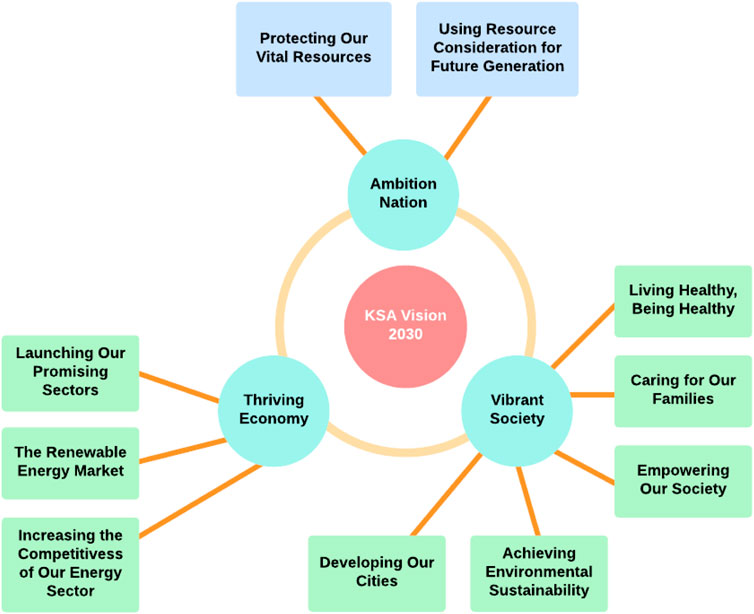
FIGURE 1. Vision 2030 and Mostadam (Modified from Mostadam Green Building Rating System, 2020).
Like other green building rating systems, Mostadam contributes to energy conservation, promotes sustainable energy usage, increases water effectiveness and recycled water use, and raises global sustainability awareness. Figures 2, 3 show Mostadam rating systems and credits (Mostadam Green Building Rating System, 2020).
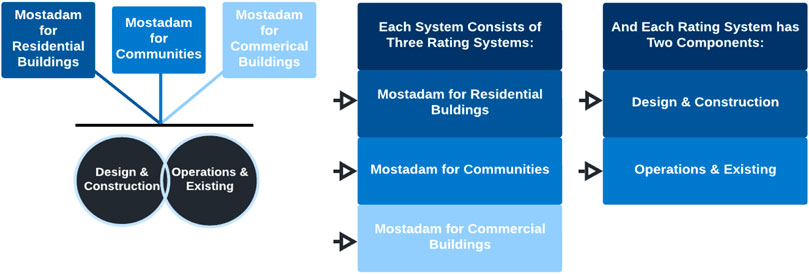
FIGURE 2. Mostadam rating systems (Modified from Mostadam Green Building Rating System, 2020).
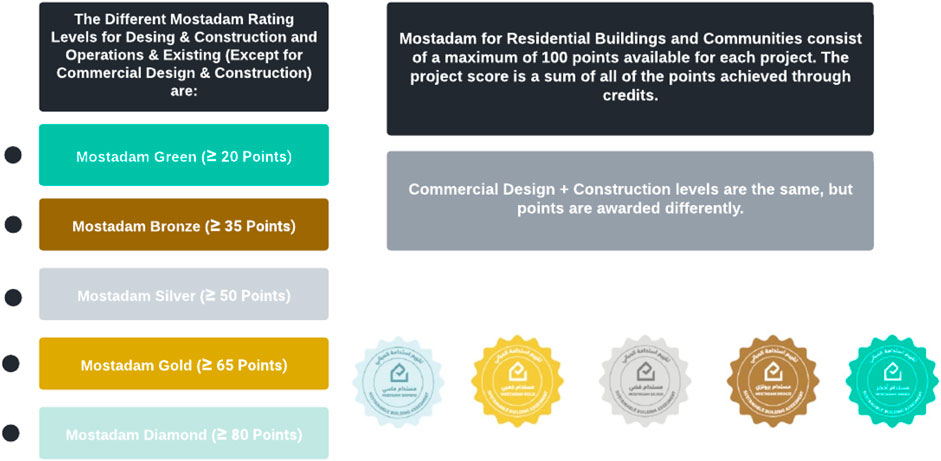
FIGURE 3. Mostadam credits (Modified from Mostadam Green Building Rating System, 2020).
An increasing number of companies and businesses are beginning to view sustainability as an instrument for profitability improvement. The adoption of UN Sustainable Development Goals is expected to provide at least $12 billion in annual business opportunities by 2030. To achieve this, companies are using frameworks such as Mostadam. The fundamental objective of Mostadam is to encourage water and energy conservation, enhance waste management, and lessen the negative impact of building operations on the surrounding environment (Alkahtani & Nordin, 2020) and (Mostadam Green Building Rating System, 2020).
As highlighted in Figure 1. The Vision 2030 prioritizes three areas—an Ambitious Nation, a Vibrant Society, and Thriving Economy. These priority areas focus on several benefits:
• Protecting vital resources.
• Using resources with consideration for future generations.
• Healthy living.
• An empowering society.
• Achieving environmental sustainability.
• Developing cities.
• Increasing the energy sector’s competitiveness.
• Improving the renewable energy market (Mostadam Green Building Rating System, 2020).
The Mostadam Rating System consists of three main categories, which are: Mostadam for Residential Buildings, Mostadam for communities, and Mostadam for Commercial buildings. Each one of these categories has two subsections (Design and Construction) and (Operations and Existing), as illustrated in Figure 2 (Mostadam Green Building Rating System, 2020).
Credits for Mostadam are illustrated in Figure 3. Mostadam credits for Residential Buildings and Communities consist of a maximum of 100 points available for each project. The project score is a sum of all of the points achieved through credits. Mostadam credits for Commercial Design + Construction levels are the same, but points are awarded differently (Mostadam Green Building Rating System, 2020).
2.5 Building information modelling
For green certification and sustainability, BIM is rich in information that stakeholders may use at various stages of the project (Autodesk 2005, 2009; Azhar et al., 2011, 2016; Mahdavinejad and Refalian, 2011; Siddiqui et al., 2019a, 2019b; Roostaie and Nawari 2022). According to Miller et al. (2015); Miller and Buys (2017), BIM is also utilized to improve the built environment’s sustainability. Different sustainable design solutions can be implemented and easily traced in the BIM model. Furthermore, advanced visualization methods such as 3D renderings, green building construction animations, and solar studies can be carried out utilizing a BIM model (Azhar et al., 2017), (5 Ways Revit Supports Green Building, 2017) and (Olanrewaju et al., 2022).
Additionally, BIM’s “computation and analysis ability of the model to quantify savings and benefits” goes far beyond simply enhancing visuals. It allows designers to gain new insights into their projects, reduce risk and save money through methods like 4D and 5D analysis and clash detection, as well as simplify the process of prefabrication and system coordination. With these advantages in mind, project members can create holistic system evaluations, address transdisciplinary problems, remove waste, and save costs. BIM is more than just a graphical tool; it is also a cohesive information modeling tool with the potential to favorably impact and influence sustainability, life cycle assessment, construction waste, rainwater harvesting, and energy efficiency (Langar, 2013), (5 Ways Revit Supports Green Building, 2017) and (Olanrewaju et al., 2022).
2.6 Building information modeling and LEED
Over the last decade, the rapid advance of building information modeling (BIM) technology has dramatically changed the traditional paper-based practice of the architecture, engineering, and construction (AEC) sector. BIM is a commonly used and effective communication platform that enables the project team to design the building/infrastructure, monitor the construction work, and manage the facilities in an integrated manner. With the growing concern about the effects and depletion of non-renewable resources, BIM is also being increasingly adopted to predict and monitor the environmental impacts of construction. Past studies in the US have demonstrated that BIM can aid different areas of sustainable design and can support the LEED certification submission process. The application of BIM also allows project stakeholders, such as clients and designers, to share a single common source of information when addressing the difficulties of decision-making in the early design and construction stages.
BIM technologies are considered to provide an effective platform for attaining compliance with sustainability rating criteria. In the past few years, the application of BIM-based technologies in sustainability rating certification has attracted increasing research attention. For example, Barnes and Castro-Lacouture demonstrated that a total of 13 credits and one prerequisite in the LEED rating system can be directly calculated and documented by Autodesk Revit. Azhar et al. (2016, 2017) also examined whether LEED credits can be directly or indirectly prepared using BIM software and suggested that 17 credits and two prerequisites, which make up a total of 38 points, can be achieved by adopting BIM software (i.e., Autodesk RevitTM and IES Virtual EnvironmentTM). These include: four credit points in the sustainable site section; five credit points in the water efficiency section; one prerequisite and five credit points in the materials and resources section; one prerequisite and one credit point in the energy and atmosphere section; five credit points in the indoor environmental quality section; and one credit point in the innovation in design section (Wong and Kuan, 2014; Wong, 2015), (5 Ways Revit Supports Green Building, 2017) and (Olanrewaju et al., 2022).
2.7 Autodesk dynamo
Autodesk Dynamo was created in 2011 (see Figure 4). It is an open-source software influenced by Visual Programming Languages (VPLs), such as Grasshopper 3D for Rhinoceros 3D (Ferreira and Leitão, 2015). Its purpose is not only to generate graphical representations of complex geometries, but also to handle information flows between Revit and cloud services or a specific database in an efficient and autonomous manner (Salamak et al., 2019) and (Mahdjoubi, Brebbia, and Laing 2015) This enables users to efficiently build Revit tools without relying on programmers to provide the necessary plug-ins (Wong, 2015). However, Autodesk Dynamo may function without a Revit connection, despite its primary goal of increasing Revit’s workflow as a plug-in by building a route into its essential core (McGinley and Fong 2015), (Sanhudo et al., 2016) and (Salamak et al., 2019).
3 Methods and materials
This study used a mixed methodology that combines qualitative and quantitative approaches. The first phase of this study focuses on reviewing the literature and collecting accessible data on the KSA’s 2030 vision. Phase II intends to collect data from AEC professionals from an online survey. Furthermore, phase II of this research entails creating the BIM-Based model using Autodesk Revit and Dynamo. Phase III entails validating the model with a case study. A new BIM-Based model based on the data obtained would help achieve the water goal of the KSA 2030 vision. The validation model will be carried out on the basis of water savings and not on the basis of other criteria considered in Mostadam certification.
Figure 5 delineates an overview of the research methodology. It consisted of three phases. Phase I “basic database and review” included the use of literature where the scope identification databases were identified and the number of articles was determined, second the selection of relevant articles was determined, third abstracts were assessed, fourth number of excluded articles were determined, and finally key sustainability parameters were determined. The data were sourced primarily from academic journals, papers in conference proceedings, books, and articles from ongoing related projects. Phase II “BIM-Based” model involved the development of the BIM-Mostadam framework to measure KSA’s 2030 vision attainment levels. Phase III “validation” consisted of a survey about BIM’s feasibility in the KSA and sustainability in the KSA, collecting data about three buildings asking about the type of these buildings and important aspect of these buildings in KSA, then integrating the findings in BIM, then selecting case studies and finally doing analysis and validation.
The following is a step-by-step roadmap of the methodology of this research:
3.1 Literature review
A literature review is conducted using the following keywords “KSA Vision 2030”; “BIM and Sustainability”; “BIM and Green Buildings”; “Building Sustainability”; “Sustainability in KSA”; “Green Buildings”; “Rating Systems in the Middle East”; “Benchmarks for Sustainability”; “Sustainability Framework”; “Sustainability Metrics.”
3.2 Feasibility survey
Starting with a proof-of-concept survey. The data is gathered through Qualtrics, an encrypted and secured online host. The survey is forwarded to KSA builders, building owners, architects, contractors, and green consultants. This survey aims to explore the possibility of using existing BIM resources to promote the green building rating system Mostadam for certification of commercial and residential buildings. This research firstly looked into the actual needs, gaps and expectations in the industry regarding why and how applicable the integration of BIM and Mostadam rating system certification is in the KSA. The survey will gather views from AEC professionals on how feasible it is in technology and operation terms to integrate BIM. This survey also looks at what professionals expect and suggest this integration to be more than just an idea, a working process. The survey findings were used as a reference for the creation of the model.
3.3 Building information modeling-based application model
The development model of the BIM-Mostadam model is achieved using Autodesk Revit and Dynamo. The BIM-Mostadam model was created based on the match-up of the Mostadam credit requirements and the functionalities available from current BIM solutions. For the purposes of this research, the Autodesk Revit software suite and Dynamo software application from Autodesk are being used.
3.4 Validation of building information modeling-based application model “case study”
The application model is validated by examining a case study. A case study was used to verify and validate the BIM-Based application model. All credits (including prerequisites) were analyzed and interpreted into data requests. Using Dynamo, a water plug-in was programmed into Revit to provide design assistance, and the total points of Mostadam certification were obtained. In addition, the total water saved was attained and compared to the baseline water consumption.
4 Dynamo building information modeling-based indoor water reduction model prototype
This section illustrates a step-by-step guide of the creation of the BIM-Based model focusing on the water category of Mostadam. Architects, engineers, designers as well as owners need to manage the complexity and all aspects of building sustainability to handle tools that are able to support them in the decision-making process. The more complex a facility is, the greater the complexity that dictates the distribution of resources.
Mostadam, the Saudi Arabian Green Building Rating System, is used in this context. Mostadam intends to adopt an iterative design approach, including stakeholders and specialists. It explains how to maximize the water use of a building facility, allowing for the careful conservation of this vital natural resource, which is becoming increasingly rare. The model is based on a match between the Mostadam credit requirements and the functionality available from current BIM solutions. This study utilizes the Autodesk Revit software suite and additional Autodesk software applications.
4.1 Indoor water use and reduction
Mostadam focuses on outdoor and indoor water consumption to decrease unnecessary water usage due to the operation and development within the built environment as well as increasing water efficiency. The goal of the Indoor Water Reduction prerequisite and credit is to minimize is to reduce the community’s indoor water use through better design and appropriate technical solutions. The Mostadam rating system needs a minimum reduction of 20%. As a result, the first step is to install performing fixtures and fittings that can use 20%–60% less water than the established baseline. It is feasible to fulfill this goal by installing WaterSense labeled products or by following the Alternative Compliance Path, which attempts to demonstrate the reduction in indoor water usage by assessing a group of parameters provided on the Reference Guide and on the fixtures cut sheet. To develop the Dynamo Water Reduction plug-in, Mostadam’s Rating System 2020 was used. Table 1 below illustrates the percentage reduction associated with the points reflected for Mostadam’s Green Building Rating System.
To demonstrate these savings, the following equation is utilized for each water fixture type:
Equation 1: Basic Indoor Water Uses Reduction Calculation (Mostadam Rating System, 2020) and (Dynamo Visual Programming, 2017).
where,
• Fixture Flush: The data from a fixture should guide us through the “efficiency first” technique. It is measured in liters per minute or liters per flush. The period of use is not required in the second situation.
• Duration of use: the amount of time a user spends using a fixture in a single session.
• Uses per person per day: the number of times each fixture is typically used each day.
• Users: this number can be implemented as a design outcome or derived via an index (gross square meters per occupant).
Equation 1 must be used to calculate the baseline water consumption as well as the design case water consumption. The rate of reduction can then be calculated. The outcome will determine if the minimal requirement (W.E.—prereq.1) is reached and, finally, the points earned (W.E.- credit.2).
Equation 2: Indoor water-use reduction (Mostadam Rating System, 2020) and (Dynamo Visual Programming, 2017)
4.2 Revit and dynamo workflow: Implementing data and results checking
Water efficiency data clearly depends on fixture kinds and specifications, the building in which they are installed, and the occupancy rate. All of this information can (or should) be integrated into the building’s BIM model, which should reproduce and supply all data linked to each discipline’s components.
As a result, the hypothesis of having plumbing fixture information and a valuation of how many people will affect indoor water consumption is entirely credible. Starting with this basic data, the goal is to establish an automatic workflow that takes this data from the BIM model and processes it in order to validate the achievement of the thresholds stated in Table 1. Then, create a user-friendly BIM application that can apply Mostadam’s calculations, requiring only a few simple inputs (included in the Mostadam Manual) and a geo-localized BIM model, which is required to investigate the computational design method.
4.3 Building information modeling-Mostadam application model
The first step is to “prepare” data within the BIM model so that it can be easily accessed and addressed once the computational design begins. This basic step necessitates a pre-design phase in which a rigorous organization (workflow strategy, parameters, steps...etc.) is required to prevent the most prominent barriers that may arise and, at times, force us to go back and restart with a new approach. The floor plan of the BIM model utilized in this investigation is depicted in Figure 6.
As a result, beginning with generic plumbing fixture Revit families, we will employ the following technique to align the BIM model with the computational design workflow:
• Insert the type of the fixture into the “comments” parameter, such as “WC,” “Faucet,” “Shower,” or “Kitchen sink,” to avoid complications caused by the various family names that fixtures may have, which can lead to difficulties in collecting similar appliances (for example, a kitchen sink, a faucet, or a shower). However, the names of various shower fixtures could be different depending on the manufacturers who supply us with the<.rfa> file, the analytical plumbing data would remain the same.
• Take into consideration a parameter that is shared by all of the different kinds of fixtures, such as the location to insert flow data in order to facilitate the streamlining of the collecting phase in Dynamo using a pattern. [lpf: liter per flush (L); lpm: liter per minute (L/m)].
• Make a valuation of building users by analyzing apartment composition.
The case study was created via Autodesk Revit. It is a one-bedroom home intended for two users. This case study was created to showcase the amount of water saved when using the Dynamo Water Reduction plug-in. The Case study highlights the amount of water saved when using the plug-in compared to the baseline water used and translated that into Mostadam certification points.
4.4 Dynamo: Collecting data and performing the script
The dynamo script can be started once the approach has been determined. The expected result is similar groups of nodes, one for each type of fixture, from which the actual performance (Revit parameter) and baseline performance (Mostadam’s table inputs) can be calculated; to complete the formula, the following should be implemented: users (given data), uses per day, and, if necessary, duration of use (see Figure 7).
To streamline this step, you can edit a custom node that allows you to complete only the fundamental inputs, resulting in a faster and smarter workflow that is easier to control and utilize (see Figure 8).
Following the application of this workflow to each plumbing fixture in the Revit model, the results must be added and compared to determine the percentage of improvement required by the Mostadam procedure. It is possible to compute points earned directly in the BIM model using this dynamo script (see Figures 9–11).
5 Results
This section addresses the results and findings of this study. It highlights the factors of BIM that should be addressed to promote green building adoption that aligns with the KSA’s 2030 vision. Based on relevant literature indicated that there are some critical aspects and challenges which have resulted in a low number of registered projects and buildings in Saudi Arabia—for instance, international sustainable building rating systems do not take into account regional differences and microclimates. The results for research questions 1, 2, and 3 are addressed by combining inferences from the literature review, survey, a case study, and the development of the BIM-Based model.
5.1 Research questions 1
5.1.1 RQ1: How can Mostadam be used to measure the attainment of the KSA 2030 vision?
Based on the review of literature and data collected from the survey and the model developed, Mostadam helped in the attainment of the KSA’s 2030 vision by creating:
• More sustainable buildings and infrastructures in KSA.
• Moving the Kingdom from its dependence on oil towards the use of its natural resources and renewable energy.
• Mostadam was an inspiration for KSA’s vision 2030; their goal perfectly aligns and supports one another.
• The Dynamo plug-in reduced the water consumption in the case study provided in comparison to the baseline consumption.
Looking at Table 2. We can see the top priorities of the Mostadam green building rating system which are (water conservation, promoting energy, human health and comfort, improving waste management, and reducing environmental impact of construction practices) are also the top priorities and the core of the KSA’s 2030. They perfectly align and support one another. From Table 2 the following remarks and comments are identified:
• The KSA 2030 vision aims to promote the optimal use of water resources by utilizing renewable and treated water and eliminating desertification aligns with the Mostadam water goal.
• The KSA 2030 vision goal of achieving maximum efficiency aligns with Mostadam Energy’s goal.
• The KSA 2030 vision seeks to enhance all aspects of the Saudi population’s development and well-being and aligns with Mostadam’s Human Health and Comfort goals.
• The KSA 2030 vision goal of enhancing the effectiveness of waste management aligns with Mostadam’s Improve waste management goal.
• The KSA 2030 vision goal of establishing major recycling projects and rehabilitating aligns with Mostadam reducing the environmental impact of construction practices.
• Even though the KSA 2030 vision goals of safeguarding beaches and natural reserves and islands, making them accessible to everyone, and reducing all types of pollution, it does not have a direct alignment with the Mostadam rating system. They are still considered a significant part of the Mostadam rating system. The purpose of this green building rating system is to preserve natural resources and reduce pollution.
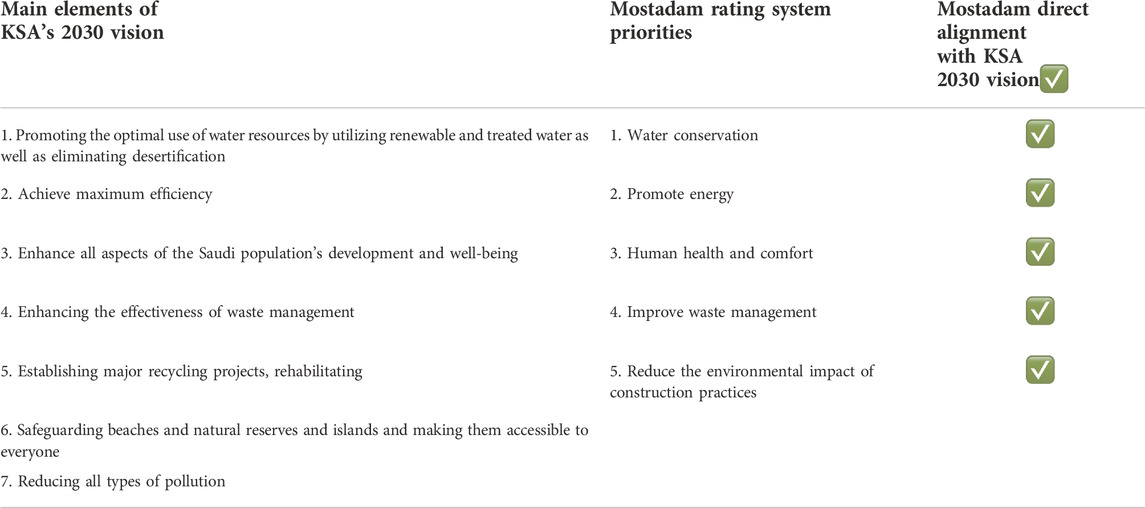
TABLE 2. A table comparing the main elements of KSA’s 2030 vision and Mostadam (Mostadam Rating System, 2020) and (Dynamo Visual Programming, 2017).
The KSA 2030 vision aims to make Saudi Arabia an ideal sustainable society by reducing its reliance on petrol, creating more sustainable buildings and infrastructures, and achieving sustainability in all aspects of life, especially in the residential and commercial buildings and sustainable city sectors. Currently, there is a notably low number of certified green buildings in Saudi Arabia compared with other Gulf countries, and the rate of change is too slow, especially with climate change and the oil shortage. However, Mostadam was recently launched. Mostadam was an inspiration of KSA’s 2030 Vision. It is a rating system used to evaluate existing and new residential and commercial buildings to assist in achieving more green buildings in Saudi Arabia. Integrating BIM’s abilities and capabilities will help accelerate the Mostadam certification process and create more sustainable buildings in Saudi Arabia, which will achieve the best effect on far-reaching advancement in Saudi Arabia to accomplish KSA 2030 vision.
5.2 Research questions 2
5.2.1 RQ2: How can Autodesk Revit be utilized to assist the Mostadam certification?
BIM technologies provide an important platform to meet requirements for sustainability ratings. Previous studies in the United States showed that BIM could help in various sustainable design areas and support the process of submitting LEED certification. BIM also helps project stakeholders, such as customers and designers, share a shared source of knowledge when discussing early design and construction decisions (Jalaei & Jrade, 2015). In recent years, research attention has increasingly paid attention to the application of BIM technology in the sustainability rating certification. In particular, Barnes and Castro-Lacouture showed that Autodesk Revit could directly measure and record a total of 13 credits and one prerequisite in the framework of LEED ratings. In addition, Azhar et al. investigated whether LEED credits can be prepared with BIM software directly or indirectly and recommended the adoption of BIM software to obtain 17 credits and two conditions that makeup 38 points in total (i.e., Autodesk RevitTM and IES Virtual EnvironmentTM) These include:
• Four credit points in the sustainable site section;
• Five credit points in the water efficiency section;
• One prerequisite and five credit points in the materials and resources section;
• One condition and one credit point in the energy and atmosphere section;
• Five credit points are in the indoor environmental quality section, and one credit point is in the innovation in design section (Wong and Kuan, 2014).
Several plug-ins exist today showing how Autodesk Revit can aid in achieving LEED green building certifications, including:
• The Automated Daylighting plug-in for LEED is a new feature in Lighting Analysis for Revit. It performs extremely fast and physically accurate daylighting simulations in the cloud, delivering results for LEED IEQc8.1 2009 directly to the design environment. The service automatically generates the information you need for submission to the GBCI (Autodesk Apps for LEED Automation, 2021).
• Autodesk Revit Insight 360 plug-in that runs analysis for illuminance and validation of LEED v3 IEQc8.1 and LEED v4 IEQ Daylight Credit, Option 2 (Crea, 2017).
Autodesk Insight empowers architects and engineers to design more energy-efficient buildings with advanced simulation engines and building performance analysis data integrated into Revit. Insight improves energy and environmental performance throughout the building lifecycle (see Table 3). It combines energy, lighting, and solar analysis for a holistic approach to creative performance design (Autodesk, 2017).

TABLE 3. A table showing the Autodesk Revit insight plug-in (5 Ways Revit Supports Green Building, 2017).
Based on past studies and literature, it has been evident that Autodesk Revit plug-ins such as Insight can help attain and accelerate LEED certification and provide better building performances. As a result, incorporating Autodesk Revit plug-ins with the Mostadam rating system will aid in the Mostadam certification process and therefore result in attaining more green buildings in the KSA.
5.3 Research questions 3
Answering question 3 is addressed by combining inferences from the literature review, survey, a case study, and the development of the BIM-Mostadam model.
5.3.1 RQ3: How can BIM be utilized to integrate the objectives of the KSA 2030 vision within the Mostadam rating system?
• Survey-The survey results were used as a guideline for more in-depth development of the BIM-Based model.
These results build on existing evidence from the AEC professionals about BIM, Mostadam, and the 2030 Vision. Upon receiving the results from the survey, it was evident that the majority of the participants were very experienced. Figure 12 below shows that 60% of the participants had more than 10 years of experience in the field. Another key demographic information gained from the survey was the participants’ educational background. Figure 13 shows that the majority of the participants were architects 32%, 15% were from a construction management background, 14% were from a sustainability and green design background, 10% were electrical engineers, 6% were mechanical and electrical engineers, and 23% were from other experiences such as (urban planners, instructors, interior designers, interior architects, professors, and faculty members at universities).
To validate the overall level of awareness of the respondents, they were first asked about their knowledge of the basic definition of green buildings. A total of 100% of the respondents answered “YES” to the question of whether or not they had heard of a green or sustainable building. Furthermore, of the total 200 participants, 180 respondents had heard of the LEED and Mostadam rating systems, which was about 80% of the total respondents. The level of awareness in the general public and stakeholders has previously been studied, and several publications share the same results, which indicate that even though the level of awareness is still not at the desired level to some, it is still rising, and more efforts are needed to increase the level in the general public.
Moving to more focused building type questions, the participants were asked about their knowledge of the Mostadam rating system on new or existing buildings (Figures 14, 15) and whether they would be willing to use the Mostadam rating system on new or existing structures. The question states: “What is your knowledge and level of experience about Mostadam? 33% of the participants just heard about it, 43% plan to use it, 14% in one project, and 10% in more than one project.
Even though the KSA’s local green building rating system, Mostadam, is available to use, it is still in its infancy compared to LEED. This lack is because Mostadam was recently launched, and it is not widely spread in the country. However, Mostadam still showed strength and acceptance to be used in conjunction with LEED. More than 40% of the selected the preference of using both rating systems, and this will substantiate the result respondents selected the importance of using both rating systems, and this will from the question on the level of awareness of the respondents to the concept of green and substantiate buildings.
• The BIM-Mostadam Application Model was designed based on matching the Mostadam credit specifications and the functionality of current BIM solutions. The Autodesk Revit software suite and an additional Autodesk Plug-in application are used for this study. The plug-in specifically targeted the water category of Mostadam’s Green Building Rating System.
• A case Study-was used to verify and validate the BIM-Based model and the water savings were apparent when using the plug-in compared to baseline water consumption.
6 Discussion
The primary goal of this study is to develop a BIM-Based model for sustainability in the Kingdom of Saudi Arabia (KSA) to achieve the KSA’s 2030 vision. This research attempts to look at the integration of BIM and green building from a systematic perspective, using the Mostadam rating system and the Mostadam certification as a unique case. The BIM plug-in was specifically used to measure the “water” category from the KSA’s 2030 vision and the water impact category of Mostadam’s.
Based on the literature review and the data collected from the surveys, various challenges exist affecting the attainment of green buildings in Saudi Arabia, including environmental factors. Because of the harsh arid climatic conditions of the country, these environmental factors must be considered in the design of a sustainable Saudi building. The literature showed that after the country’s “oil-boom” phase, the design of Saudi buildings was sadly and irrationally mimicking Western-housing designs. This shift in design practices not only neglected the cultural needs, as discussed earlier but neglected the environmental needs that resulted in the vast sums of energy consumed to cool the indoor environment. Several environmental factors were extracted from the literature review, including:
• Passive cooling
• Energy saving
• Water insulation (interior insulation)
• Water conservation
• Thermal insulation
• Thermal comfort
• Landscape
• Site orientation.
Moreover, the issues related to sustainable building materials and techniques in the Saudi construction industry need to be considered. All these factors indicate the need to develop local rating systems such as Mostadam.
7 Conclusion
Building Information Modeling (BIM) can significantly aid in developing a unified building performance analysis to ensure a more sustainable building design. BIM and green buildings are two main factors in the AEC field. Additionally, this research acknowledges factors of BIM that should be addressed to promote green building adoption that aligns with the KSA’s 2030 vision. Recent literature indicated that some critical aspects and challenges have resulted in a low number of registered green projects and buildings in Saudi Arabia. For instance, international sustainable building rating systems do not consider regional differences and microclimates. As a result, it is essential to develop local rating systems such as Mostadam.
This research acknowledges BIM and green buildings as the two major trends in the AEC industry. Based on that premise, it proposes a new strategy for the AEC professionals to achieve a green building certification such as Mostadam through integrating BIM and green building rating systems. In response to the research goals, the first step was to conduct a feasibility analysis survey to investigate the two most fundamental questions in the BIM and Mostadam integration: 1) What does Mostadam require; and 2) What BIM can provide to achieve the KSA 2030 vision.
Based on Saudi Arabia’s vision 2030 for achieving sustainability in all aspects of life, especially in the residential and commercial buildings and sustainable cities sectors, the “Mostadam” rating system was recently launched to evaluate existing and new commercial and residential buildings. This can be considered a result of the notably low number of certified green buildings in Saudi Arabia compared with other Gulf countries. This research uses a survey to examine the present status of sustainable structures in Saudi urban communities. The study aims to develop a BIM-Based application model to assist in implementing the Mostadam rating system. The proposed model seeks to achieve the sustainability aspects of the Mostadam green rating system and certification while supporting the KSA’s 2030 vision. The suggested model is validated by the data collected from the survey and a case study.
The current rate of gasoline supply in the Kingdom of Saudi Arabia is unsustainable. As a result, the Kingdom established its 2030 vision to solve this issue. The 2030 vision seeks to make the KSA a more sustainable society by reducing its dependency on fossil resources. Even though green buildings are being built in many countries worldwide, they do not have the same recognition and acceptance in Saudi Arabia. The absence of rules and regulations promoting the country’s sustainability and green buildings has revealed this gap. Due to the low number of green buildings in Saudi Arabia, this study intended to develop a new BIM-Based model for Sustainable Built Environments in Saudi Arabia that meets the Kingdom’s 2030 vision, specifically water conservation. The Dynamo plug-in is able to calculate water saved/reduced compared to the baseline water consumption and transform that into percentages of reduction. Based on the rate of reduction (20%–60% from baseline consumption), the points earned towards the Mostadam Green Building rating system can be calculated. Therefore, the BIM-Based application model can improve sustainability in the KSA by reducing water consumed and translating that into points earned towards the Mostadam Green building rating system which supports and aligns with the KSA vision of 2030. The Saudi Vision 2030 has set a plan for future generations to succeed and live in a stable economic environment in which the private and governmental sectors collaborate to increase the country’s income and natural resources. As a result, Mostadam and the KSA vision 2030 can be attained using the proposed BIM-Based application model.
Data availability statement
The original contributions presented in the study are included in the article/supplementary material, further inquiries can be directed to the corresponding author.
Author contributions
FH and NN: Substantial contributions to the conception or design of the work; or the acquisition—analysis or interpretation of data for the work—drafting the work or revising it critically for important intellectual content; provide approval for publication of the content—agree to be accountable for all aspects of the work in ensuring that questions related to the accuracy or integrity of any part of the work are appropriately investigated and resolved.
Conflict of interest
The authors declare that the research was conducted in the absence of any commercial or financial relationships that could be construed as a potential conflict of interest.
Publisher’s note
All claims expressed in this article are solely those of the authors and do not necessarily represent those of their affiliated organizations, or those of the publisher, the editors and the reviewers. Any product that may be evaluated in this article, or claim that may be made by its manufacturer, is not guaranteed or endorsed by the publisher.
References
5 Ways Revit Supports Green Building, 20175 Ways Revit Supports Green Building (2017). 5 Ways Revit supports green building. Available at https://blogs.autodesk.com/revit/2017/11/08/5-ways-revit-supports-green-building/.
AIA (2014). Integrated project delivery: An Updated working definition AIA California Council. Sacramento, CA. Available at http://www.aiacc.org/wp-content/uploads/2014/07/AIACC_IPD.pdf.
Alkahtani, A., and Nordin, N. (2020). Conceptual framework of green-building adoption among construction companies in Saudi Arabia: The effect of proactive entrepreneurial Behavior, green product innovation, and government support. Int. J. Industrial Manag. 8, 35–42. doi:10.15282/ijim.8.0.2020.5761
Almasoud, S. (2016). Transforming Saudi Arabia: National Transformation Program 2020 approved. LONDON, UK. Available at http://www.shearman.com/∼/medial/Files/NesInsights/Publications/2016/06/Transforming-Saudi-Arabia-National-Transformation-Program-2020-Approved-PDF-061016.pdf.
Autodesk Apps for LEED Automation (2021). U.S. Green building Council. Available at https://www.usgbc.org/resources/autodesk-apps-leed-automation.
Autodesk (2009). Improving building industry results through integrated project delivery and building information modeling. USA: Integrated Project Delivery and Building Information Modeling.
Autodesk (2005). Building information modelling (BIM) for sustainable building design. Facilities 31, 138–157. doi:10.1108/02632771311299412
Azhar, S., Brown, J., and Farooqui, R. (2016). “BIM-Based sustainability analysis,” in An Evaluation of building performance analysis software (Gainesville: Building Information Modeling), 1–9.
Azhar, S., Brown, J., and Farooqui, R. (2017). BIM-Based sustainability analysis: An evaluation of building performance analysis software. Build. Inf. Model. 2017, 1–9.
Azhar, S., Carlton, W. A., Olsen, D., and Ahmad, I. (2011). Building information modeling for sustainable design and LEED® rating analysis. Automation Constr. 20 (2), 217–224. doi:10.1016/j.autcon.2010.09.019
Balabel, A., and Alwetaishi, M. (2021). Towards sustainable residential buildings in Saudi Arabia According to the conceptual framework of “Mostadam” rating system and vision 2030. Sustainability 13 (2), 793. doi:10.3390/su13020793
Burck, J., Marten, F., and Bals, C. (2013). The climate change performance index: Results 2014. CCPI.
Conca, J. (2015). U.S. Winning oil war against Saudi Arabia. Available at https://www.forbes.com/sites/jamesconca/2015/07/22/u-s-winning-oil-war-against-saudi-arabia/#231a59a81678.
Counsell, J. (2016). “Beyond level 2 BIM Web portals and collaboration tools,” in Information Visualisation (IV), 2016 16th International Conference, Montpellier, France, 11-13 July 2012 (IEEE), 510–515.
Crea, J. (2017). Saudi green building Forum joins LEED international Roundtable. Available at https://www.usgbc.org/articles/saudi-green-building-forum-joins-leed-international-roundtable.
Dynamo visual programming, (2017). BIM and LEED: Implementing design data to streamline the process. LinkedIn. Available at https://www.linkedin.com/pulse/dynamo-visual-programming-bim-leed-implementing-data-di-ciaccio/.
EIA. (2020). Overview: Saudi Arabia. U.S. Energy information Administration (EIA). Available at http://www.eia.gov/countries/cab.cfm?fips=SA.
Everett, R., Boyle, G., Peake, S., and Ramage, J. (2017). Energy systems and sustainability: Power for a sustainable future. Oxford University Press.
Ferreira, B., and Leitão, A. (2015). “Generative design for building information modeling,” in Real Time - Proceedings of the 33rd eCAADe Conference 1 (eCAADe):Mahdjoubi, Lamine, CA Brebbia, and Richard Laing Building information modelling (BIM) in design, construction and operations, Mahdjoubi, Lamine, CA Brebbia, 2015 (WIT Press).
Government of Saudi Arabia (2016). Saudi Arabia’s vision for 2030. Available at http://vision2030.gov.sa/en.
Hashmi, N. (2016). Saudi’s strategic vision for 2030. Washington DC: National Transformation Program 2020. vision2030.gov.sa/sites/default/files/NTP_En.pdf.
Hashmi, R., and Alam, K. (2019). Dynamic relationship among environmental regulation, innovation, CO2 emissions, population, and economic growth in OECD countries: A panel investigation. J. Clean. Prod. 231, 1100–1109. doi:10.1016/j.jclepro.2019.05.325
Insight Building Performance Analysis Software (2020). Autodesk. Available at https://www.autodesk.com/products/insight/overview.Mostadam.Manual.pdf.2019.
Jaffe, A. B., Newell, R. G., and Stavins, R. N. (2005). A tale of two market failures: Technology and environmental policy. Ecol. Econ. 54, 164–174. doi:10.1016/j.ecolecon.2004.12.027
Jalaei, F., and Jrade, A. (2015). Integrating building information modeling (BIM) and LEED system at the conceptual design stage of sustainable buildings. Sustain. Cities Soc. 18, 95–107. doi:10.1016/j.scs.2015.06.007
Jurgenson, S., Bayyari, F. M., and Parker, J. (2016). A comprehensive renewable energy program for Saudi Vision 2030. Renew. Energy Focus 17, 182–183. doi:10.1016/j.ref.2016.08.006
Karam, S. (2010). Can Saudi Arabia fix its housing time bomb?, Reuters. Available at http://www.reuters.com/article/2010/08/26/us-saudi-real-estate-idUSTRE67P2CQ20100826.
Kibert, C. (1994). “Sustainable construction,”, Tampa, Florida, USA, November 6-9, 1994 (University of Florida).Proceedings of the first international conference of CIB TG 16
Kibert, C. J. (2007). The next generation of sustainable construction. Build. Res. Inf. 35, 595–601. doi:10.1080/09613210701467040
Kibert, C. J., Sendzimir, J., and Guy, B. G. (2002). Construction Ecology nature as the basis for green buildings. 1st Edition. New York, NY: Spon Press.
Langar, S. (2013). The Role of building information modeling (BIM) in the implementation of rainwater harvesting technologies and Strategies (RwHTS). Build. Inf. Model. 23 (1), 11–50.
Mahdavinejad, M. J., and Refalian, G. (2011). "Architectural design process simulation and computer- based modeling.". J. Adv. Comput. Sci. Technol. Res. 1 (2011), 74–83.
Mahdjoubi, L., Brebbia, C. A., and Laing, R. (2015). “Building information modelling (BIM) in design,” in Construction and operations (WIT Press), 149.
Mahmood, H., Alkhateeb, T. T. Y., Al-Qahtani, M. M. Z., Allam, Z., Ahmad, N., and Furqa, M. (2020). Urbanization, oil price and pollution in Saudi Arabia. Int. J. Energy Econ. Policy 10 (2), 477–482. doi:10.32479/ijeep.8914
Mahmood, H., Alkhateeb, T. T. Y., and Furqan, M. (2020). Oil sector and CO2 emissions in Saudi Arabia: Asymmetry analysis. Palgrave Commun. 6 (1), 88. doi:10.1057/s41599-020-0470-z
McGinley, Tim, and Fong, Darren (2015). ““DESIGNGHOSTS - Mapping occupant behaviour in BIM.” emerging experience in past, present and future of Digital architecture,” in Proceedings of the 20th International Conference of the Association for Computer-Aided Architectural Design Research in Asia, Hong-Kong, 2015 (CAADRIA).
Miller, D., Doh, J.-H., Panuwatwanich, K., and van Oers, N. (2015). The contribution of structural design to green building rating systems: An industry perspective and comparison of life cycle energy considerations. Sustain. Cities Soc. 16, 39–48. doi:10.1016/j.scs.2015.02.003
Miller, W., and Buys, L. (2017). Factors influencing sustainability outcomes of housing in subtropical Australia. Smart Sustain. Built Environ. 2 (1), 60–83.
Mosly, I. (2016). Barriers to the Diffusion and adoption of green buildings in Saudi Arabia. Available at http://www.ccsenet.org/journal/index.php/jms/article/view/54413.
Mostadam Green Building Rating System (2020). Alpin limited. Available at https://www.alpinme.com/mostadam/.
Mubarak, F. A., and Nawari, N. (1999). “Cultural adaptation to housing needs: A case study,” in IAHS Conference Proceedings Building and Environment, Riyadh, Saudi Arabia, 1999, June (Elsvier), 108113. doi:10.1016/j.buildenv.2021.108113
Olanrewaju, O. I., Kineber, A. F., Chileshe, N., and Edwards, D. J. (2022). Modelling the relationship between Building Information Modelling (BIM) implementation barriers, usage and awareness on building project lifecycle. Build. Environ. 207, 108556. doi:10.1016/j.buildenv.2021.108556
Rahman, S., and Khondaker, A. (2012). Mitigation measures to reduce greenhouse gas emissions and enhance carbon capture and storage in Saudi Arabia. Renew. Sustain. Energy Rev. 16 (5), 2446–2460. doi:10.1016/j.rser.2011.12.003
Roostaie, S., and Nawari, N. (2022). The DEMATEL approach for integrating resilience indicators into building sustainability assessment frameworks. Build. Environ. 207, 108113. doi:10.1016/j.buildenv.2021.108113
Salamak, M., Jasinski, M., Plaszczyk, T., and Zarski, M. (2019). Analytical modelling in dynamo. Trans. VŠB – Tech. Univ. Ostrava, Civ. Eng. Ser. 18 (2), 36–43. doi:10.31490/tces-2018-0014
Sanhudo, L. P. N., Almeida, M., Braganca, L., and Mateus, R. (2016). BIM-based energy analysis and sustainability assessment—application to Portuguese buildings. Buildings 11, 246. doi:10.3390/buildings11060246
Siddiqui, A., Mahmood, H., and Margaritis, D. (2019a). Oil prices and stock markets during the 2014-16 oil price slump: Asymmetries and speed of adjustment in GCC and oil-importing countries. Emerg. Mark. Finance Trade 56, 3678–3708. doi:10.1080/1540496X.2019.1570497
Siddiqui, M. Z., Pearce, A. R., Ku, K., Langar, S., Ahn, Y. H., and Jacocks, K. (2019b). “Green BIM approaches to architectural design for increased sustainability,” in Proceedings of the International Conference on Construction Engineering and Management/Project Management (ICCEM-ICCPM), Jeju, Korea, May 27–30 2019 (Energy, Sustainability and Society).
Singh, V., Gu, N., and Wang, X. (2019). A theoretical framework of a BIM- based multi-disciplinary collaboration platform. Automation Constr. 20, 134–144. doi:10.1016/j.autcon.2010.09.011
Taleb, H., and Pitts, A. (2009). The potential to exploit use of building-integrated photovoltaics in countries of the Gulf Cooperation Council. Renew. Energy 34 (4), 1092–1099. doi:10.1016/j.renene.2008.07.002
Thérivel, R., and Paridario, M. R. (2016). The practice of strategic environmental assessment. Routledge.
Trusty, W. B. (2000). Introducing an assessment tool classification system. Adv. Build. Newsl. 25 (7). http://aesl.hyu.ac.kr/resource/blcc/assess-typology-tool.pdf.
Wong, J. K.-W., and Kuan, K.-L. (2014). Implementing ‘BEAM Plus’ for BIM-based sustainability analysis. Automation Constr. 44, 163–175. doi:10.1016/j.autcon.2014.04.003
Wong, W. (2015). Dynamo: More than Grasshopper lite. Available at http://www.case-inc.com/node/488.html.
Keywords: BIM, sustainable built environment, sustainable buildings, green building rating system, Saudi Arabia, 2030 vision
Citation: Hasanain FA and Nawari NO (2022) BIM-based model for sustainable built environment in Saudi Arabia. Front. Built Environ. 8:950484. doi: 10.3389/fbuil.2022.950484
Received: 22 May 2022; Accepted: 03 October 2022;
Published: 29 November 2022.
Edited by:
Assed N. Haddad, Federal University of Rio de Janeiro, BrazilReviewed by:
Bruno Barzellay Ferreira Da Costa, Federal University of Rio de Janeiro, BrazilAna Catarina Evangelista, Engineering Institute of Technology (EIT), Australia
Mohammad K. Najjar, Federal University of Rio de Janeiro, Brazil
Copyright © 2022 Hasanain and Nawari. This is an open-access article distributed under the terms of the Creative Commons Attribution License (CC BY). The use, distribution or reproduction in other forums is permitted, provided the original author(s) and the copyright owner(s) are credited and that the original publication in this journal is cited, in accordance with accepted academic practice. No use, distribution or reproduction is permitted which does not comply with these terms.
*Correspondence: Fatma A. Hasanain, Zmhhc2FuYWluQHVmbC5lZHU=; Nawari O. Nawari, bm5hd2FyaUB1ZmwuZWR1
 Fatma A. Hasanain
Fatma A. Hasanain Nawari O. Nawari
Nawari O. Nawari